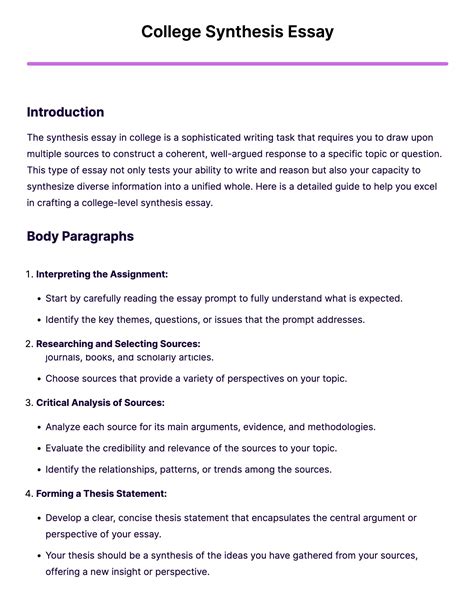Introduction
A synthesis essay showcases your ability to amalgamate information from various sources, present multiple viewpoints, and form a nuanced argument. This comprehensive template will guide you through the intricacies of writing a successful synthesis essay.

Body Paragraphs
1. Establish the Context:
– Begin with a hook to pique reader interest.
– Provide background information on the topic.
– State your thesis statement: a concise statement that expresses your overall argument.
2. Source A: Introduce and Summarize:
– Introduce the first source by citing the author and credibility.
– Summarize the key points of the source, focusing on its perspective and evidence.
– Analyze the source’s strengths and potential weaknesses.
3. Source B: Compare and Contrast:
– Introduce the second source and compare its perspective to that of the first source.
– Highlight similarities and differences in evidence and reasoning.
– Analyze the relative strengths and weaknesses of each source.
4. Source C: Synthesize and Integrate:
– Introduce the third source and incorporate it into your discussion.
– Connect the perspectives of the sources to support your thesis.
– Draw parallels, identify common themes, or explore alternative interpretations.
Conclusion
1. Restate Thesis and Highlight Contributions:
– Restate your thesis and summarize your main points.
– Emphasize how the synthesis of perspectives has enhanced your understanding and argumentation.
2. Reflect on Implications:
– Discuss the broader implications of the topic based on the synthesis of perspectives.
– Consider future research directions or applications.
Tips and Tricks
- Annotate Sources: Take notes on key points, evidence, and your own thoughts while reading each source.
- Create an Outline: Organize your ideas logically before writing to ensure a coherent flow.
- Utilize Transition Words: Connect ideas smoothly using words like “however,” “in contrast,” or “in addition to.”
- Weave Evidence: Integrate quotations or paraphrased information from the sources to support your claims.
- Provide Citations: Properly cite all sources to avoid plagiarism.
Comparative Table of Sources
| Source | Perspective | Evidence | Strengths | Weaknesses |
|---|---|---|---|---|
| Source A | Proponent’s View | Numerous case studies | Empirical data supporting claims | Limited scope |
| Source B | Skeptic’s View | Anecdotal evidence | Challenges assumptions of Source A | Lack of empirical data |
| Source C | Synthesized Perspective | Combines evidence from A and B | Provides a multifaceted view | Requires careful interpretation |
Applications of Synthesis
Synthesis is not limited to academic writing; it has practical applications across various fields:
- Policy Analysis: Synthesizing perspectives from experts, stakeholders, and research can inform policy decisions.
- Innovation: Combining ideas and technologies from different domains can foster innovation and solve complex problems.
- Interdisciplinary Research: Collaboration and synthesis among disciplines can lead to breakthroughs in fields such as health, climate science, and social sciences.
- Case Studies: Analyzing multiple case studies can provide a holistic understanding of a phenomenon or issue.
FAQs
1. How many sources should I include?
Typically, 3-5 sources provide a sufficient range of perspectives.
2. Can I include my own opinions?
Yes, but ensure to clearly distinguish between your opinions and the perspectives presented in the sources.
3. How do I avoid bias?
Critically evaluate sources for credibility, avoid overreliance on any one perspective, and consider counterarguments.
4. How long should a synthesis essay be?
The length varies depending on the topic and requirements, but generally around 5-10 pages or 1,500-3,000 words.
5. Can I use different types of sources?
Yes, consider using a mix of scholarly articles, books, interviews, and data sets to provide a comprehensive analysis.
6. How do I conclude a strong synthesis essay?
Reflect on the implications of the topic, highlight the strengths and limitations of your analysis, and consider future directions for research or application.
